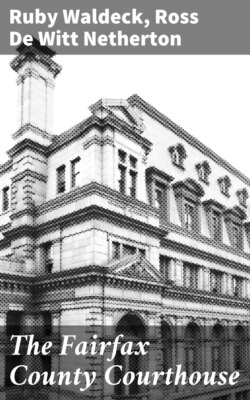Читать книгу The Fairfax County Courthouse - Ross De Witt Netherton - Страница 5
На сайте Литреса книга снята с продажи.
INTRODUCTION
ОглавлениеTable of Contents
Each generation of Americans has acknowledged its debt to Virginia's leaders whose skill in politics was demonstrated so well in a half-century that saw independence achieved and a new republic established. They were products of a system of government which itself had been perfected over more than 150 years before the colonies declared their independence. To these men—George Washington, George Mason, Thomas Jefferson, Patrick Henry, John Marshall, George Wythe, James Madison, and the Carters—the County court was an academy for education in the art of government. Important as it was to sit in the House of Burgesses at Williamsburg, the lessons of politics and public administration were learned best in the work of carrying on the government of a county. Virginia counties were unique in colonial history, for the considerable degree of autonomy enjoyed by the County courts gave them both a taste of responsibility for a wide range of public affairs and a measure of insulation from the changes of political fortune which determined events in Williamsburg, and later Richmond.
In Virginia, the county courthouse was the focal point of public affairs. Usually built in a central location, with more regard for accessibility from all corners of the county than for proximity to established centers of commerce, the courthouse came to be a unique complex of buildings related to the work of the court. In time, most of these clusters of buildings grew into towns or cities, but throughout the eighteenth and nineteenth centuries many places shown on Virginia maps as "Court House" consisted literally of a county courthouse and its related structures standing alone beside a crossroads.
On court days, however, the scene changed. The monthly sessions of the court, conducted in colonial times by the "Gentleman Justices", provided opportunities to transact all manner of public business—from issuing licenses and collecting taxes to hearing litigation and holding elections. They also were social events and market days; there people came to meet their friends, hear the news, see who came circuit-riding with the justices, sell their produce, and buy what they needed.
In the two centuries since independence, profound changes have occurred in all phases of life that were centered in the courthouse. In Fairfax County, the pace and extent of these changes have been extensive. Architectural historians who note uniqueness in the fact that Virginia courthouses developed as a complex of related buildings may see ominous symbolism in the fact that today one of the structures in the cluster around Fairfax County's courthouse is a modern fifteen-story county office building. Yet, at the same time this office building was being planned, workmen were rehabilitating the original section of the courthouse to represent its presumed appearance in an earlier time, thus providing a reminder of the historic role of county government in Virginia.
| Five Colonial Justices of the Fairfax County Court | |
| George Mason. | George Washington. |
| Bryan, later eighth Lord Fairfax. | Thomas, sixth Lord Fairfax. | George William Fairfax. |
